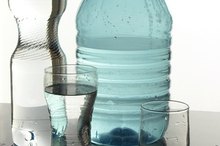Recommended Calories Per Day for Women
The number of calories a woman should eat each day generally depends on her age and activity level. Younger women need more calories than older women, and more active women can eat more than those who are sedentary. However, other factors such as pregnancy, breast-feeding and whether a woman needs to gain, lose or maintain weight also play a role.
National Institutes of Heath Suggestions
The National Institutes of Heath offer a chart for women and men, childhood through adulthood, to help determine appropriate caloric intake. For women, those aged 19 to 25 are allowed the most calories on this chart, ranging from 2,000 to 2,400 calories per day depending on activity level. Sedentary women ages 51 and older should consume the least amount, at 1,600 a day. A sedentary lifestyle is one with less than 30 minutes a day of moderate physical activity. Moderately active is getting 30 to 60 minutes a day, and active is 60 minutes or more.
- The National Institutes of Heath offer a chart for women and men, childhood through adulthood, to help determine appropriate caloric intake.
- For women, those aged 19 to 25 are allowed the most calories on this chart, ranging from 2,000 to 2,400 calories per day depending on activity level.
Balanced Diet
How Many Calories & Grams of Fat Should a Female Consume?
Learn More
According to Medline Plus, a service of the National Institutes of Health, a 2,000-calorie-per-day diet should include 2 cups of fruit, 2 1/2 cups of vegetables, 3 ounces or more of whole-grain items and 3 cups of fat-free or low-fat milk or milk products per day. Total fat should be no more than 20 to 35 percent of calories, and the fat should be "good" fats from fish, nuts and oils containing polyunsaturated and monounsaturated fats. Lean, low-fat or fat-free meat, poultry, beans and milk also are good choices.
Cautions
Trans fat, found in fried food, commercial baked goods and margarine, is unhealthy fat that you should avoid. In addition, take in less than 300 milligrams of cholesterol per day and reduce your intake of added sugars. Women should consume fewer than 2,300 milligrams of sodium and limit alcohol consumption to one or fewer alcoholic beverages per day. Reading nutrition labels on food is vital to understanding what is in the products you buy.
- Trans fat, found in fried food, commercial baked goods and margarine, is unhealthy fat that you should avoid.
- In addition, take in less than 300 milligrams of cholesterol per day and reduce your intake of added sugars.
How to Track
How Many Milliliters of Water Should You Drink a Day?
Learn More
To track daily calorie consumption, a food and drink diary is one of the best tools, according to the Centers for Disease Control and Prevention. Writing down what you eat and drink increases your awareness of what you consume. It's also a good idea to jot down your physical activity and its duration. Each person's body is different, but food and activity journals can help you achieve the energy balance needed to maintain a healthy weight.
- To track daily calorie consumption, a food and drink diary is one of the best tools, according to the Centers for Disease Control and Prevention.
- Each person's body is different, but food and activity journals can help you achieve the energy balance needed to maintain a healthy weight.
Weight Loss
The minimum a woman should consume daily is 1,200 calories, according to Medline Plus. One pound of fat equals about 3,500 calories. To lose one pound a week, a woman should reduce her calories or increase her physical activity by 500 calories a day. To lose two pounds a week, a deficit of 1,000 calories is needed. Some recommendations include avoiding foods high in fat and sugar and performing aerobic exercise at least 30 minutes a day, three times a week.
- The minimum a woman should consume daily is 1,200 calories, according to Medline Plus.
- To lose two pounds a week, a deficit of 1,000 calories is needed.
Related Articles
References
- National Institutes of Heath: DASH Eating Plan
- Centers for Disease Control and Prevention: Balancing calories
- A new predictive equation for resting energy expenditure in healthy individuals - PubMed
- Estimation of energy expenditure using prediction equations in overweight and obese adults: a systematic review - PubMed
- Validity of predictive equations to estimate RMR in females with varying BMI - PubMed
- Appendix 2. Estimated Calorie Needs per Day, by Age, Sex, and Physical Activity Level - 2015-2020 Dietary Guidelines | health.gov
- Protein intake and energy balance - PubMed
- Increased Dietary Protein as a Dietary Strategy to Prevent and/or Treat Obesity
- Effect of protein overfeeding on energy expenditure measured in a metabolic chamber - PubMed
- Dietary Protein and Energy Balance in Relation to Obesity and Co-morbidities - PubMed
- Effect of protein overfeeding on energy expenditure measured in a metabolic chamber - PubMed
- Presence or absence of carbohydrates and the proportion of fat in a high-protein diet affect appetite suppression but not energy expenditure in normal-weight human subjects fed in energy balance - PubMed
- Gluconeogenesis and energy expenditure after a high-protein, carbohydrate-free diet - PubMed
- A high-protein diet for reducing body fat: mechanisms and possible caveats
- A high-protein diet induces sustained reductions in appetite, ad libitum caloric intake, and body weight despite compensatory changes in diurnal plasma leptin and ghrelin concentrations - PubMed
- The effects of consuming frequent, higher protein meals on appetite and satiety during weight loss in overweight/obese men - PubMed
- Dietary Strategies for Weight Loss Maintenance - PubMed
- Dietary protein - its role in satiety, energetics, weight loss and health - PubMed
- High Compared with Moderate Protein Intake Reduces Adaptive Thermogenesis and Induces a Negative Energy Balance during Long-term Weight-Loss Maintenance in Participants with Prediabetes in the Postobese State: A PREVIEW Study - PubMed
- Effects of food form and timing of ingestion on appetite and energy intake in lean young adults and in young adults with obesity - PubMed
- Effects of fruit and vegetable, consumed in solid vs beverage forms, on acute and chronic appetitive responses in lean and obese adults - PubMed
- Sugar-sweetened beverages and weight gain in children and adults: a systematic review and meta-analysis - PubMed
- Resolved: there is sufficient scientific evidence that decreasing sugar-sweetened beverage consumption will reduce the prevalence of obesity and obesity-related diseases - PubMed
- Adverse metabolic effects of dietary fructose: results from the recent epidemiological, clinical, and mechanistic studies - PubMed
- Water-induced thermogenesis - PubMed
- Water drinking induces thermogenesis through osmosensitive mechanisms - PubMed
- Water-induced thermogenesis and fat oxidation: a reassessment - PubMed
- Immediate pre-meal water ingestion decreases voluntary food intake in lean young males - PubMed
- Water consumption increases weight loss during a hypocaloric diet intervention in middle-aged and older adults - PubMed
- Tea catechin and caffeine activate brown adipose tissue and increase cold-induced thermogenic capacity in humans - PubMed
- Caffeine enhances activity thermogenesis and energy expenditure in rats - PubMed
- The effects of caffeine intake on weight loss: a systematic review and dos-response meta-analysis of randomized controlled trials - PubMed
- Caffeine intake is related to successful weight loss maintenance - PubMed
- Preserving Healthy Muscle during Weight Loss
- Exercise acts as a drug; the pharmacological benefits of exercise - PubMed
- The essential role of exercise in the management of type 2 diabetes - PubMed
- A Systematic Review of Exercise Systematic Reviews in the Cancer Literature (2005-2017) - PubMed
- Benefits of exercise training on cardiovascular dysfunction: molecular and integrative - PubMed
- Exercise in the treatment of clinical anxiety in general practice - a systematic review and meta-analysis - PubMed
- The effects of a low-carbohydrate diet on appetite: A randomized controlled trial - PubMed
- Effects of low-carbohydrate and low-fat diets: a randomized trial - PubMed
- Effects of low-carbohydrate and low-fat diets: a randomized trial - PubMed
- Dietary Intervention for Overweight and Obese Adults: Comparison of Low-Carbohydrate and Low-Fat Diets. A Meta-Analysis - PubMed
- The Effects of a Low-Carbohydrate Diet vs. a Low-Fat Diet on Novel Cardiovascular Risk Factors: A Randomized Controlled Trial
- The Effect of Low-Carbohydrate Diet on Glycemic Control in Patients with Type 2 Diabetes Mellitus - PubMed
Resources
Writer Bio
Ann McGlynn has been a writer since 1996. Her work has appeared in newspapers throughout the Midwest, including the "Quad-City Times," the "Des Moines Register" and the "Waterloo-Cedar Falls Courier." McGlynn holds a Bachelor of Arts in journalism from the University of Iowa.









